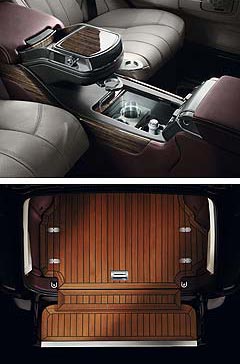Geneva show: Luxo Range Rover has iPads onboard
BY MIKE COSTELLO | 11th Feb 2011

Called the Ultimate Edition, the special model features a specially handcrafted interior using extra-soft leather and ‘kalahari’ wood inserts, as well as super yacht-inspired teak floorboards in the loading area.
Land Rover has also teamed up with Apple, fitting iPad tablet computers behind the front headrests as standard in what the brand describes as a world first for the car industry.
The redesigned back seats also gain a machined aluminium laptop table and drinks chiller, leading the car-maker to call the Ultimate Edition the “definitive chauffeur vehicle”.
Other distinguishing features include two new exterior colours dubbed Roussillon Red or Otago Stone, along with a ‘dark atlas’ grille and side vents and unique 20-inch alloy wheels.

Land Rover claims the turbo-diesel variant will hustle from 0-100km/h in 7.5 seconds, while the supercharged petrol Range Rover manages to get the gargantuan SUV from 0-100km/h in just 5.9 seconds.
Five hundred units will be produced for 20 global markets at the Range Rover factory in the UK, with each built to customer order.
Land Rover Australia has advised it is currently reviewing the model for local sale, and that if it reached these shores the starting price would likely be “well over $200,000”.
Considering the current flagship Autobiography Black retails for $239,700 here, a figure closer to $300,000 does not seem out of the equation.
Meanwhile, the next-generation Range Rover – codenamed L405 – is tipped to be publicly unveiled by the end of 2012.
Overseas reports indicate the new SUV will gain all-alloy construction, helping it to shed up to 450kg over the current model. It is also likely to see improvements in interior space and quality, while CO2 emissions on the entry-level models are tipped to drop to around 200g/km.